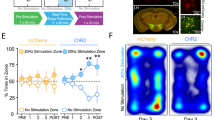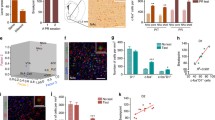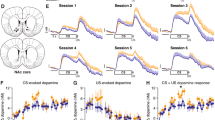Abstract
Rationale
Prior research suggests that the neural pathway from the lateral hypothalamic area (LHA) to the paraventricular nucleus of the thalamus (PVT) mediates the attribution of incentive salience to Pavlovian reward cues. However, a causal role for the LHA and the neurotransmitters involved have not been demonstrated in this regard.
Objectives
To examine (1) the role of LHA in the acquisition of Pavlovian conditioned approach (PavCA) behaviors, and (2) the role of PVT orexin 1 receptors (OX1r) and orexin 2 receptors (OX2r) in the expression of PavCA behaviors and conditioned reinforcement.
Methods
Rats received excitotoxic lesions of the LHA prior to Pavlovian training. A separate cohort of rats characterized as sign-trackers (STs) or goal-trackers (GTs) received the OX1r antagonist SB-334867, or the OX2r antagonist TCS-OX2-29, into the PVT, to assess their effects on the expression of PavCA behavior and on the conditioned reinforcing properties of a Pavlovian reward cue.
Results
LHA lesions attenuated the development of sign-tracking behavior. Administration of either the OX1r or OX2r antagonist into the PVT reduced sign-tracking behavior in STs. Further, OX2r antagonism reduced the conditioned reinforcing properties of a Pavlovian reward cue in STs.
Conclusions
The LHA is necessary for the development of sign-tracking behavior; and blockade of orexin signaling in the PVT attenuates the expression of sign-tracking behavior and the conditioned reinforcing properties of a Pavlovian reward cue. Together, these data suggest that LHA orexin inputs to the PVT are a key component of the circuitry that encodes the incentive motivational value of reward cues.





Similar content being viewed by others
References
Ahrens AM, Singer BF, Fitzpatrick CJ, Morrow JD, Robinson TE (2016) Rats that sign-track are resistant to Pavlovian but not instrumental extinction. Behav Brain Res 296:418–430. https://doi.org/10.1016/j.bbr.2015.07.055
Anand BK, Brobeck JR (1951) Localization of a “feeding center” in the hypothalamus of the rat. Proc Soc Exp Biol Med 77:323–324. https://doi.org/10.3181/00379727-77-18766
Barson JR, Ho HT, Leibowitz SF (2015) Anterior thalamic paraventricular nucleus is involved in intermittent access ethanol drinking: role of orexin receptor 2. Addict Biol 20:469–481. https://doi.org/10.1111/adb.12139
Berendse HW, Groenewegen HJ (1990) Organization of the thalamostriatal projections in the rat, with special emphasis on the ventral striatum. J Comp Neurol 299:187–228. https://doi.org/10.1002/cne.902990206
Berridge KC (2001) Reward learning: reinforcement, incentives, and expectations. Psychol Learn Motiv 40:223–278
Berridge KC, Robinson TE (2003) Parsing reward. Trends Neurosci 26:507–513. https://doi.org/10.1016/S0166-2236(03)00233-9
Bindra D (1978) How adaptive-behavior is produced - perceptual-motivational alternative to response-reinforcement. Behav Brain Sci 1:41–52. https://doi.org/10.1017/S0140525x00059380
Campus P, Covelo IR, Kim Y, Parsegian A, Kuhn BN, Lopez SA, Neumaier JF, Ferguson SM, Solberg Woods LC, Sarter M, Flagel SB (2019) The paraventricular thalamus is a critical mediator of top-down control of cue-motivated behavior in rats. Elife 8. https://doi.org/10.7554/eLife.49041
Canteras NS, Simerly RB, Swanson LW (1995) Organization of projections from the medial nucleus of the amygdala: a PHAL study in the rat. J Comp Neurol 360:213–245. https://doi.org/10.1002/cne.903600203
Cardinal RN, Parkinson JA, Hall J, Everitt BJ (2002) Emotion and motivation: the role of the amygdala, ventral striatum, and prefrontal cortex. Neurosci Biobehav Rev 26:321–352
Cason AM, Aston-Jones G (2013) Role of orexin/hypocretin in conditioned sucrose-seeking in rats. Psychopharmacology 226:155–165. https://doi.org/10.1007/s00213-012-2902-y
Chen S, Su H-S (1990) Afferent connections of the thalamic paraventricular and parataenial nuclei in the rat — a retrograde tracing study with iontophoretic application of Fluoro-Gold. Brain Res 522:1–6. https://doi.org/10.1016/0006-8993(90)91570-7
Cheng J, Wang J, Ma X, Ullah R, Shen Y, Zhou YD (2018) Anterior paraventricular thalamus to nucleus accumbens projection is involved in feeding behavior in a novel environment. Front Mol Neurosci 11:202. https://doi.org/10.3389/fnmol.2018.00202
Choi DL, Davis JF, Magrisso IJ, Fitzgerald ME, Lipton JW, Benoit SC (2012) Orexin signaling in the paraventricular thalamic nucleus modulates mesolimbic dopamine and hedonic feeding in the rat. Neuroscience 210:243–248. https://doi.org/10.1016/j.neuroscience.2012.02.036
Choi EA, Jean-Richard-Dit-Bressel P, Clifford CWG, McNally GP (2019) Paraventricular thalamus controls behavior during motivational conflict. J Neurosci 39:4945–4958. https://doi.org/10.1523/jneurosci.2480-18.2019
Cofresi RU, Bartholow BD, Piasecki TM (2019) Evidence for incentive salience sensitization as a pathway to alcohol use disorder. Neurosci Biobehav Rev 107:897–926. https://doi.org/10.1016/j.neubiorev.2019.10.009
Cole S, Mayer HS, Petrovich GD (2015) Orexin/hypocretin-1 receptor antagonism selectively reduces cue-induced feeding in sated rats and recruits medial prefrontal cortex and thalamus. Sci Rep 5:16143. https://doi.org/10.1038/srep16143
de Lecea L, Kilduff TS, Peyron C, Gao XB, Foye PE, Danielson PE, Fukuhara C, Battenberg ELF, Gautvik VT, Bartlett FS, Frankel WN, van den Pol AN, Bloom FE, Gautvik KM, Sutcliffe JG (1998) The hypocretins: Hypothalamus-specific peptides with neuroexcitatory activity. Proc Natl Acad Sci U S A 95:322–327. https://doi.org/10.1073/pnas.95.1.322
Devenport LD, Balagura S (1971) Lateral hypothalamus: reevaluation of function in motivated feeding behavior. Science 172:744–746. https://doi.org/10.1126/science.172.3984.744
DiLeone RJ, Georgescu D, Nestler EJ (2003) Lateral hypothalamic neuropeptides in reward and drug addiction. Life Sci 73:759–768. https://doi.org/10.1016/s0024-3205(03)00408-9
Duricki DA, Soleman S, Moon LD (2016) Analysis of longitudinal data from animals with missing values using SPSS. Nat Protoc 11:1112–1129. https://doi.org/10.1038/nprot.2016.048
Fitzpatrick CJ, Geary T, Creeden JF, Morrow JD (2019) Sign-tracking behavior is difficult to extinguish and resistant to multiple cognitive enhancers. Neurobiol Learn Mem 163:107045. https://doi.org/10.1016/j.nlm.2019.107045
Flagel SB, Watson SJ, Robinson TE, Akil H (2007) Individual differences in the propensity to approach signals vs goals promote different adaptations in the dopamine system of rats. Psychopharmacology 191:599–607. https://doi.org/10.1007/s00213-006-0535-8
Flagel SB, Akil H, Robinson TE (2009) Individual differences in the attribution of incentive salience to reward-related cues: implications for addiction. Neuropharmacology 56(Suppl 1):139–148. https://doi.org/10.1016/j.neuropharm.2008.06.027
Flagel SB, Robinson TE, Clark JJ, Clinton SM, Watson SJ, Seeman P, Phillips PEM, Akil H (2010) An animal model of genetic vulnerability to behavioral disinhibition and responsiveness to reward-related cues: implications for addiction. Neuropsychopharmacology 35:388–400. https://doi.org/10.1038/npp.2009.142
Flagel SB, Cameron CM, Pickup KN, Watson SJ, Akil H, Robinson TE (2011) A food predictive cue must be attributed with incentive salience for it to induce c-fos mRNA expression in cortico-striatal-thalamic brain regions. Neuroscience 196:80–96. https://doi.org/10.1016/j.neuroscience.2011.09.004
Frank DW, Cinciripini PM, Deweese MM, Karam-Hage M, Kypriotakis G, Lerman C, Robinson JD, Tyndale RF, Vidrine DJ, Versace F (2019) Toward precision medicine for smoking cessation: developing a neuroimaging-based classification algorithm to identify smokers at higher risk for relapse. Nicotine Tob Res 22:1277–1284. https://doi.org/10.1093/ntr/ntz211
Haight JL, Flagel SB (2014) A potential role for the paraventricular nucleus of the thalamus in mediating individual variation in Pavlovian conditioned responses. Front Behav Neurosci 8:79. https://doi.org/10.3389/fnbeh.2014.00079
Haight JL, Fraser KM, Akil H, Flagel SB (2015) Lesions of the paraventricular nucleus of the thalamus differentially affect sign- and goal-tracking conditioned responses. Eur J Neurosci 42:2478–2488. https://doi.org/10.1111/ejn.13031
Haight JL, Fuller ZL, Fraser KM, Flagel SB (2017) A food-predictive cue attributed with incentive salience engages subcortical afferents and efferents of the paraventricular nucleus of the thalamus. Neuroscience 340:135–152. https://doi.org/10.1016/j.neuroscience.2016.10.043
Hearst E, Jenkins HM (1974) Sign-tracking: The stimulus-reinforcer relation and directed action. Monograph of the Psychonomic Society. Austin, TX
Hellberg SN, Russell TI, Robinson MJF (2019) Cued for risk: evidence for an incentive sensitization framework to explain the interplay between stress and anxiety, substance abuse, and reward uncertainty in disordered gambling behavior. Cogn Affect Behav Neurosci 19:737–758. https://doi.org/10.3758/s13415-018-00662-3
Heydendael W, Sharma K, Iyer V, Luz S, Piel D, Beck S, Bhatnagar S (2011) Orexins/hypocretins act in the posterior paraventricular thalamic nucleus during repeated stress to regulate facilitation to novel stress. Endocrinology 152:4738–4752. https://doi.org/10.1210/en.2011-1652
Hsu DT, Price JL (2009) Paraventricular thalamic nucleus: subcortical connections and innervation by serotonin, orexin, and corticotropin-releasing hormone in macaque monkeys. J Comp Neurol 512:825–848. https://doi.org/10.1002/cne.21934
Hughson AR, Horvath AP, Holl K, Palmer AA, Solberg Woods LC, Robinson TE, Flagel SB (2019) Incentive salience attribution, “sensation-seeking” and “novelty-seeking” are independent traits in a large sample of male and female heterogeneous stock rats. Sci Rep 9:2351. https://doi.org/10.1038/s41598-019-39519-1
James MH, Dayas CV (2013) What about me...? The PVT: a role for the paraventricular thalamus (PVT) in drug-seeking behavior. Front Behav Neurosci 7:18. https://doi.org/10.3389/fnbeh.2013.00018
Keefer SE, Cole S, Petrovich GD (2016) Orexin/hypocretin receptor 1 signaling mediates Pavlovian cue-food conditioning and extinction. Physiol Behav 162:27–36. https://doi.org/10.1016/j.physbeh.2016.02.042
Kelley AE, Baldo BA, Pratt WE (2005) A proposed hypothalamic-thalamic-striatal axis for the integration of energy balance, arousal, and food reward. J Comp Neurol 493:72–85. https://doi.org/10.1002/cne.20769
Kirouac GJ, Parsons MP, Li S (2005) Orexin (hypocretin) innervation of the paraventricular nucleus of the thalamus. Brain Res 1059:179–188. https://doi.org/10.1016/j.brainres.2005.08.035
Kirouac GJ, Parsons MP, Li S (2006) Innervation of the paraventricular nucleus of the thalamus from cocaine- and amphetamine-regulated transcript (CART) containing neurons of the hypothalamus. J Comp Neurol 497:155–165. https://doi.org/10.1002/cne.20971
Kolaj M, Zhang L, Hermes ML, Renaud LP (2014) Intrinsic properties and neuropharmacology of midline paraventricular thalamic nucleus neurons. Front Behav Neurosci 8:132. https://doi.org/10.3389/fnbeh.2014.00132
Kuhn BN, Campus, P., Flagel S.B. (2018a) Chapter 3: The neurobiological mechanisms underlying sign-tracking behavior. In: Morrow J, Tomie A (eds). Sign-tracking and drug addiction. Michigan Publishing, Ann Arbor. https://doi.org/10.3998/mpub.10215070
Kuhn BN, Klumpner MS, Covelo IR, Campus P, Flagel SB (2018b) Transient inactivation of the paraventricular nucleus of the thalamus enhances cue-induced reinstatement in goal-trackers, but not sign-trackers. Psychopharmacology 235:999–1014. https://doi.org/10.1007/s00213-017-4816-1
Lee JS, Lee EY, Lee HS (2015) Hypothalamic, feeding/arousal-related peptidergic projections to the paraventricular thalamic nucleus in the rat. Brain Res 1598:97–113. https://doi.org/10.1016/j.brainres.2014.12.029
Li S, Kirouac GJ (2008) Projections from the paraventricular nucleus of the thalamus to the forebrain, with special emphasis on the extended amygdala. J Comp Neurol 506:263–287. https://doi.org/10.1002/cne.21502
Li S, Kirouac GJ (2012) Sources of inputs to the anterior and posterior aspects of the paraventricular nucleus of the thalamus. Brain Struct Funct 217:257–273. https://doi.org/10.1007/s00429-011-0360-7
Li Y, Li S, Wei C, Wang H, Sui N, Kirouac GJ (2010) Orexins in the paraventricular nucleus of the thalamus mediate anxiety-like responses in rats. Psychopharmacology 212:251–265. https://doi.org/10.1007/s00213-010-1948-y
Li Y, Wang H, Qi K, Chen X, Li S, Sui N, Kirouac GJ (2011) Orexins in the midline thalamus are involved in the expression of conditioned place aversion to morphine withdrawal. Physiol Behav 102:42–50. https://doi.org/10.1016/j.physbeh.2010.10.006
Li S, Shi Y, Kirouac GJ (2014) The hypothalamus and periaqueductal gray are the sources of dopamine fibers in the paraventricular nucleus of the thalamus in the rat. Front Neuroanat 8. https://doi.org/10.3389/fnana.2014.00136
Mahler SV, de Wit H (2010) Cue-reactors: Individual differences in cue-induced craving after food or smoking abstinence. PLoS One 5:e15475. https://doi.org/10.1371/journal.pone.0015475
Mahler SV, Smith RJ, Moorman DE, Sartor GC, Aston-Jones G (2012) Multiple roles for orexin/hypocretin in addiction. Prog Brain Res 198:79–121. https://doi.org/10.1016/B978-0-444-59489-1.00007-0
Marcus JN, Elmquist JK (2006) Orexin projections and localization of orexin receptors. In: Nishino S, Sakurai T (eds) The orexin/hypocretin system: physiology and pathophysiology, vol Contemporary Clinical Neuroscience. Humana Press Inc., Totowa, pp 21–43
Margules DL, Olds J (1962) Identical “feeding” and “rewarding” systems in the lateral hypothalamus of rats. Science 135:374–375. https://doi.org/10.1126/science.135.3501.374
Martin-Fardon R, Boutrel B (2012) Orexin/hypocretin (Orx/Hcrt) transmission and drug-seeking behavior: is the paraventricular nucleus of the thalamus (PVT) part of the drug seeking circuitry? Front Behav Neurosci 6:75. https://doi.org/10.3389/fnbeh.2012.00075
Matzeu A, Martin-Fardon R (2018) Drug seeking and relapse: new evidence of a role for orexin and dynorphin co-transmission in the paraventricular nucleus of the thalamus. Front Neurol 9:720. https://doi.org/10.3389/fneur.2018.00720
Matzeu A, Zamora-Martinez ER, Martin-Fardon R (2014) The paraventricular nucleus of the thalamus is recruited by both natural rewards and drugs of abuse: recent evidence of a pivotal role for orexin/hypocretin signaling in this thalamic nucleus in drug-seeking behavior. Front Behav Neurosci 8:117. https://doi.org/10.3389/fnbeh.2014.00117
Matzeu A, Kerr TM, Weiss F, Martin-Fardon R (2016) Orexin-A/hypocretin-1 mediates cocaine-seeking behavior in the posterior paraventricular nucleus of the thalamus via orexin/hypocretin receptor-2. J Pharmacol Exp Ther 359:273–279. https://doi.org/10.1124/jpet.116.235945
Meyer PJ, Lovic V, Saunders BT, Yager LM, Flagel SB, Morrow JD, Robinson TE (2012) Quantifying individual variation in the propensity to attribute incentive salience to reward cues. PLoS One 7:e38987. https://doi.org/10.1371/journal.pone.0038987
Nieh EH, Matthews GA, Allsop SA, Presbrey KN, Leppla CA, Wichmann R, Neve R, Wildes CP, Tye KM (2015) Decoding neural circuits that control compulsive sucrose seeking. Cell 160:528–541. https://doi.org/10.1016/j.cell.2015.01.003
Nieh EH, Vander Weele CM, Matthews GA, Presbrey KN, Wichmann R, Leppla CA, Izadmehr EM, Tye KM (2016) Inhibitory input from the lateral hypothalamus to the ventral tegmental area disinhibits dopamine neurons and promotes behavioral activation. Neuron 90:1286–1298. https://doi.org/10.1016/j.neuron.2016.04.035
Otis JM, Zhu MH, Namboodiri VMK, Cook CA, Kosyk O, Matan AM, Ying R, Hashikawa Y, Hashikawa K, Trujillo-Pisanty I, Guo J, Ung RL, Rodriguez-Romaguera J, Anton ES, Stuber GD (2019) Paraventricular thalamus projection neurons integrate cortical and hypothalamic signals for cue-reward processing. Neuron 103(423-431):e424–431.e4. https://doi.org/10.1016/j.neuron.2019.05.018
Paolone G, Angelakos CC, Meyer PJ, Robinson TE, Sarter M (2013) Cholinergic control over attention in rats prone to attribute incentive salience to reward cues. J Neurosci 33:8321–8335. https://doi.org/10.1523/JNEUROSCI.0709-13.2013
Parsons MP, Li S, Kirouac GJ (2006) The paraventricular nucleus of the thalamus as an interface between the orexin and CART peptides and the shell of the nucleus accumbens. Synapse 59:480–490. https://doi.org/10.1002/syn.20264
Parsons MP, Li S, Kirouac GJ (2007) Functional and anatomical connection between the paraventricular nucleus of the thalamus and dopamine fibers of the nucleus accumbens. J Comp Neurol 500:1050–1063. https://doi.org/10.1002/cne.21224
Paxinos G, Watson C (2007) The rat brain in stereotaxin coordinates, 6th edn. Academic Press, Burlingame
Petrovich GD, Hobin MP, Reppucci CJ (2012) Selective Fos induction in hypothalamic orexin/hypocretin, but not melanin-concentrating hormone neurons, by a learned food-cue that stimulates feeding in sated rats. Neuroscience 224:70–80. https://doi.org/10.1016/j.neuroscience.2012.08.036
Pinto A, Jankowski M, Sesack SR (2003) Projections from the paraventricular nucleus of the thalamus to the rat prefrontal cortex and nucleus accumbens shell: ultrastructural characteristics and spatial relationships with dopamine afferents. J Comp Neurol 459:142–155. https://doi.org/10.1002/cne.10596
Ren S, Wang Y, Yue F, Cheng X, Dang R, Qiao Q, Sun X, Li X, Jiang Q, Yao J, Qin H, Wang G, Liao X, Gao D, Xia J, Zhang J, Hu B, Yan J, Wang Y, Xu M, Han Y, Tang X, Chen X, He C, Hu Z (2018) The paraventricular thalamus is a critical thalamic area for wakefulness. Science 362:429–434. https://doi.org/10.1126/science.aat2512
Robinson TE, Berridge KC (1993) The neural basis of drug craving: an incentive-sensitization theory of addiction. Brain Res Brain Res Rev 18:247–291
Robinson TE, Flagel SB (2009) Dissociating the predictive and incentive motivational properties of reward-related cues through the study of individual differences. Biol Psychiatry 65:869–873. https://doi.org/10.1016/j.biopsych.2008.09.006
Sakurai T (2014) The role of orexin in motivated behaviours. Nat Rev Neurosci 15:719–731. https://doi.org/10.1038/nrn3837
Sakurai T, Amemiya A, Ishii M, Matsuzaki I, Chemelli RM, Tanaka H, Williams SC, Richardson JA, Kozlowski GP, Wilson S, Arch JRS, Buckingham RE, Haynes AC, Carr SA, Annan RS, McNulty DE, Liu WS, Terrett JA, Elshourbagy NA, Bergsma DJ, Yanagisawa M (1998) Orexins and orexin receptors: a family of hypothalamic neuropeptides and G protein-coupled receptors that regulate feeding behavior. Cell 92:573–585. https://doi.org/10.1016/s0092-8674(00)80949-6
Sarter M, Phillips KB (2018) The neuroscience of cognitive-motivational styles: sign- and goal-trackers as animal models. Behav Neurosci 132:1–12. https://doi.org/10.1037/bne0000226
Steimer T (2011) Animal models of anxiety disorders in rats and mice: some conceptual issues. Dialogues Clin Neurosci 13:495–506
Stratford TR, Wirtshafter D (2013) Injections of muscimol into the paraventricular thalamic nucleus, but not mediodorsal thalamic nuclei, induce feeding in rats. Brain Res 1490:128–133. https://doi.org/10.1016/j.brainres.2012.10.043
Stuber GD, Wise RA (2016) Lateral hypothalamic circuits for feeding and reward. Nat Neurosci 19:198–205. https://doi.org/10.1038/nn.4220
Su H-S, Bentivoglio M (1990) Thalamic midline cell populations projecting to the nucleus accumbens, amygdala, and hippocampus in the rat. J Comp Neurol 297:582–593. https://doi.org/10.1002/cne.902970410
Tyree SM, de Lecea L (2017) Lateral hypothalamic control of the ventral tegmental area: reward evaluation and the driving of motivated behavior. Front Syst Neurosci 11:50. https://doi.org/10.3389/fnsys.2017.00050
Van der Werf YD, Witter MP, Groenewegen HJ (2002) The intralaminar and midline nuclei of the thalamus. Anatomical and functional evidence for participation in processes of arousal and awareness. Brain Res Rev 39:107–140
Verbeke G, Molenberghs G (2009) Linear mixed models for longitudinal data. Springer series in statistics. Springer, New York
Versace F, Kypriotakis G, Basen-Engquist K, Schembre SM (2016) Heterogeneity in brain reactivity to pleasant and food cues: evidence of sign-tracking in humans. Soc Cogn Affect Neurosci 11:604–611. https://doi.org/10.1093/scan/nsv143
Vertes RP (2004) Differential projections of the infralimbic and prelimbic cortex in the rat. Synapse 51:32–58. https://doi.org/10.1002/syn.10279
Vertes RP, Hoover WB (2008) Projections of the paraventricular and paratenial nuclei of the dorsal midline thalamus in the rat. J Comp Neurol 508:212–237. https://doi.org/10.1002/cne.21679
Vogt B, Hof P, Friedman D, Sikes R, Vogt L (2008) Norepinephrinergic afferents and cytology of the macaque monkey midline, mediodorsal, and intralaminar thalamic nuclei. Brain Struct Funct 212:465–479. https://doi.org/10.1007/s00429-008-0178-0
Yager LM, Pitchers KK, Flagel SB, Robinson TE (2015) Individual variation in the motivational and neurobiological effects of an opioid cue. Neuropsychopharmacology 40:1269–1277. https://doi.org/10.1038/npp.2014.314
Yin HH, Ostlund SB, Balleine BW (2008) Reward-guided learning beyond dopamine in the nucleus accumbens: the integrative functions of cortico-basal ganglia networks. Eur J Neurosci 28:1437–1448. https://doi.org/10.1111/j.1460-9568.2008.06422.x
Zhu Y, Nachtrab G, Keyes PC, Allen WE, Luo L, Chen X (2018) Dynamic salience processing in paraventricular thalamus gates associative learning. Science 362:423–429. https://doi.org/10.1126/science.aat0481
Funding
This work was supported by the National Institute on Drug Abuse branch of the National Institutes of Health (T32DA007268 [IRC], R01DA038599 [SBF], F31DA037680 [JLH], T32DA007821 [BNK], K08DA037912 and R01DA044960 [JDM]) and the National Science Foundation (GRFP [CMR]).
Author information
Authors and Affiliations
Corresponding author
Ethics declarations
Competing interests
The authors declare that they have no conflict of interest.
Additional information
Publisher’s note
Springer Nature remains neutral with regard to jurisdictional claims in published maps and institutional affiliations.
Joshua L Haight and Paolo Campus are co-first authors.
Electronic supplementary material
Supplementary Figure 1
(PNG 484 kb)
Supplementary Figure 2
(PNG 183 kb)
Supplementary Figure 3
(PNG 172 kb)
Supplementary Figure 4
(PNG 170 kb)
ESM 1
(DOCX 43 kb)
Rights and permissions
About this article
Cite this article
Haight, J.L., Campus, P., Maria-Rios, C.E. et al. The lateral hypothalamus and orexinergic transmission in the paraventricular thalamus promote the attribution of incentive salience to reward-associated cues. Psychopharmacology 237, 3741–3758 (2020). https://doi.org/10.1007/s00213-020-05651-4
Received:
Accepted:
Published:
Issue Date:
DOI: https://doi.org/10.1007/s00213-020-05651-4




